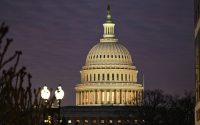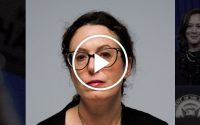The United Method Church Comes Apart
With 17,000 members, White’s Chapel Methodist Church in Southlake, Texas, offers multiple worship services each weekend along with the kind of attractions that only the largest houses of worship can boast: a coffee shop, an indoor playground, a Christmas festival with pony rides and fireworks, and near-daily opportunities for volunteering and socializing. On Sunday mornings, a small white bulldog named Wesley, after the founder of Methodism, roams the campus with a handler, greeting admirers.
“They call this place the biggest small church,” said Linda Rutan, who was sitting with her husband near a sprawling holiday train set on a recent Sunday morning. The Rutans have attended White’s Chapel since they moved to Texas from California in 2022. “It’s so friendly,” she said, “you don’t feel like it’s a huge church.”
Until July, White’s Chapel was the second-largest United Methodist congregation in the country. The conservative-leaning church lost its status this year not because it shrank — it is growing, leaders say — but because it left the denomination.
America’s second-largest Protestant denomination is in the final stages of a slow-motion rupture that has so far seen the departure of a quarter of the nation’s roughly 30,000 United Methodist churches, according to the denomination’s news agency.
At issue for Methodists is the question of ordaining and marrying L.G.B.T.Q. people, a topic that has splintered many other Protestant denominations and which Methodists have been debating for years.
In 2019, Methodist leaders opened a window for any congregations to leave over “reasons of conscience,” in most cases allowing them to take their property and assets with them in a clean break if they received approval to depart by Dec. 31, 2023. Many conservative congregations have done just that.
“It’s the biggest denominational schism ever,” said Ryan Burge, a political scientist at Eastern Illinois University. There were eight million Methodists in the United States in 2020, according to the U.S. Religion Census. Between large-scale departures and the broader trend of decline, Dr. Burge said, that number could drop by half in a decade.
The exodus marks a calamitous decline for the broader tradition of mainline Protestantism, which once dominated the American religious, social and cultural landscape.
Now, as the deadline approaches, remaining congregations and leaders are taking stock of their losses, and looking ahead to a future in which the denomination’s footprint in the United States may continue to shrink (even as it grows overseas, especially in Africa). In Texas, a historic stronghold for United Methodists, more than 40 percent of churches have left.
“It’s significant, and it’s been at a high cost,” said Thomas Bickerton, a lifelong Methodist who is president of the denomination’s Council of Bishops. More than 7,500 congregations have left since 2019, a number that he said was slightly higher than leaders expected when they extended the offer. Next year, Methodists plan to vote on what will likely be their lowest quarterly budget in 40 years.
Officially, the United Methodist Church still forbids same-sex marriage and does not allow “self-avowed, practicing” gay people to serve as ministers. But in recent years, some leaders began defying official restrictions on the practices, and the church now has a number of openly gay clergy and two gay bishops. Many anticipate that church law could change — and spur more departures — at the denomination’s quadrennial meeting next spring in Charlotte, N.C.
That meeting was initially planned for 2020 but was delayed multiple times in response to the coronavirus pandemic. In the meantime, conservatives launched a rival denomination, the Global Methodist Church, which says it will not ordain or marry gay people. As of this fall, the new denomination said that more than 3,000 congregations had joined it.
White’s Chapel is helping to launch another new denomination, the Methodist Collegiate Church, of which it will serve as the inaugural “cathedral.” Many other departing churches have opted to remain independent of any denomination so far.
The Methodist movement’s history traces back to 18th-century England, when preacher John Wesley proposed a “method” for encouraging deeper commitment to the Christian life, including small group meetings and an emphasis on holiness and service. In the United States, the faith grew quickly in the 19th century as circuit riders crisscrossed the country preaching and establishing churches. Methodists have ordained women since the 1950s, a topic that has divided many Protestant traditions but remains uncontroversial within Methodism.
After a series of mergers and schisms, the current United Methodist Church — by far the largest expression of Methodism — was established in Dallas in 1968. As of 2020, only the Southern Baptist Convention was bigger among Protestant denominations.
Historically, United Methodism has been a denomination marked by both geographical and ideological diversity. Justice Harry A. Blackmun, who wrote the Supreme Court opinion establishing the right to abortion in Roe v. Wade, was a Methodist; so is President George W. Bush, who signed the Partial-Birth Abortion Ban Act 30 years later. The list of 31 current members of Congress who are Methodist includes conservative Republican senator Tom Cotton of Arkansas and his progressive Democratic colleague Elizabeth Warren of Massachusetts.
But the era of big-tent Methodism may now be ending, as conservative congregations exit. Mr. Cotton’s lifelong congregation, now known as Dardanelle Methodist Church, left the denomination this year and joined the Global Methodists. An analysis this summer found that departing churches were disproportionately white, located in the South and likelier to be led by male pastors.
The United Methodist Church is part of the tradition of mainline Protestantism that now tends to be broadly progressive in its theology and traditional in its worship style. In the mid-20th century, more than two-thirds of Americans identified as Protestants. Now, most surveys show less than 15 percent of the country identifies with the mainline, a group that also includes the Episcopal Church and the Evangelical Lutheran Church in America.
The split is the latest in decades of divides in Christian denominations over questions about sexuality and theology. Most mainline denominations now endorse same-sex marriage — and most have seen significant shares of their churches break off into new denominations that maintain their traditions and worship styles while restoring what they describe as theological orthodoxy.
Mr. Bickerton, the bishop, said that many of the congregations that left the United Methodists seemed to be motivated as much by a desire for financial independence as by deep theological differences.
“We’ve learned this is not as much about human sexuality as we thought,” he said. “This is about power, control and money.”
That’s not the language that the leaders of White’s Chapel use to describe their decision to leave. But they acknowledge that their congregation’s dissatisfaction with United Methodism went beyond its approach to sexuality.
In Southlake, congregants were increasingly wary of the direction of the national denomination’s theology. But they were also unhappy with the Methodist policy of moving pastors to new locations every three years. Money was an issue, too. Because of its extraordinary growth, White’s Chapel paid the denomination about $600,000 annually, and had lost confidence that its money was being well spent by a remote administrative bureaucracy, said Rev. Larry Duggins, a longtime member who the church hired to help manage the separation process.
“We wanted to see, where was that money going?” said Rev. Duggins, who is now chancellor of the new Methodist Collegiate Church denomination. “We weren’t happy with what we saw.” Too much of the money, the church felt, was going to administrative overhead rather than into its core missions.
Last year, 93 percent of church members voted to leave, a decision that was formalized this summer.
For many of the members, the vote signaled that their theological and political values were increasingly out of step with mainline Christianity.
“There’s been a trend toward liberalizing a lot of things in society, not just churches,” said Bruce Krieger, who has attended the church since the 1990s. The sexuality question had become a political football, he said, where liberals in the denomination wanted to show their allegiance to a wider slate of progressive causes that Mr. Krieger and his wife — “conservative folks” — were increasingly uncomfortable with.
They voted to leave.
Sunday mornings have not changed much since White’s Chapel left the United Methodists, in Mr. Krieger’s view. The Christmas season had begun, and he was looking forward to the all-church brunch after a special service that would include a live Nativity scene — a longstanding tradition.
Some people had left after the vote, but not many, he said, and newcomers have already arrived to take their place.


